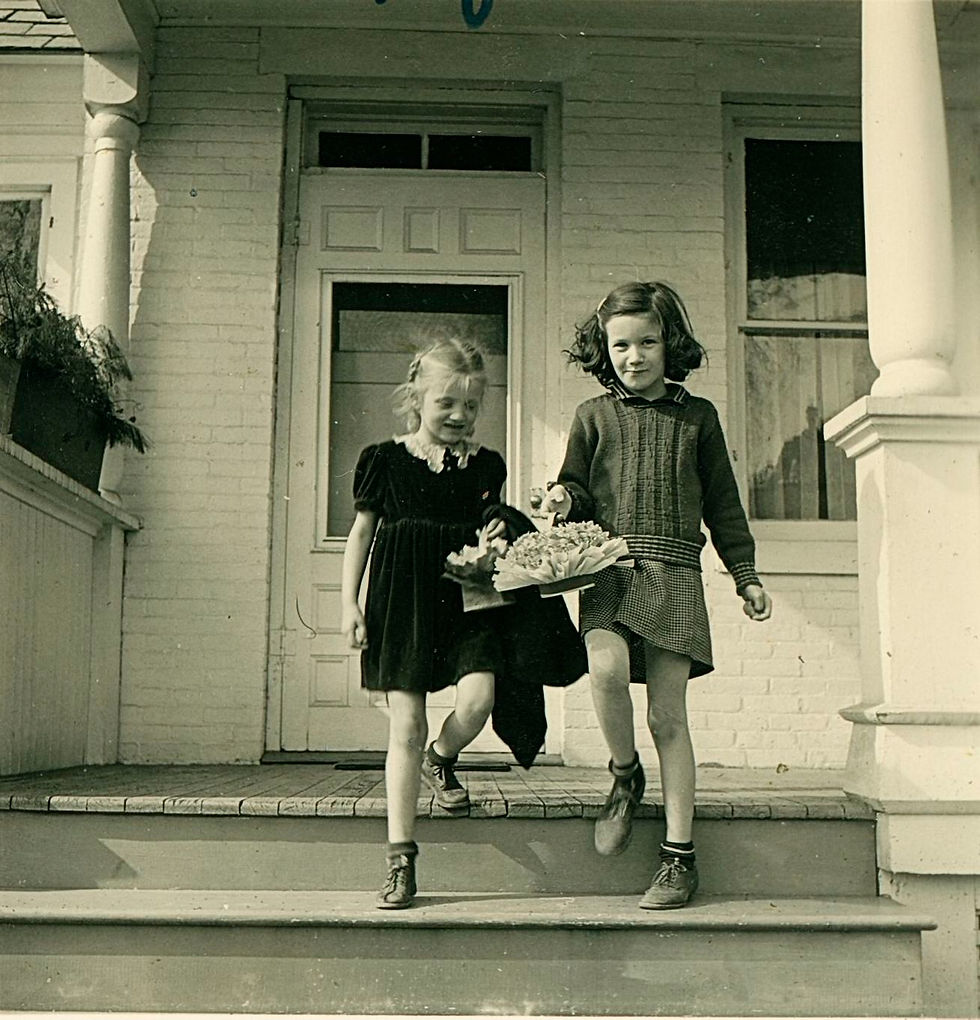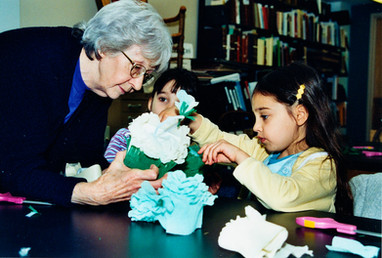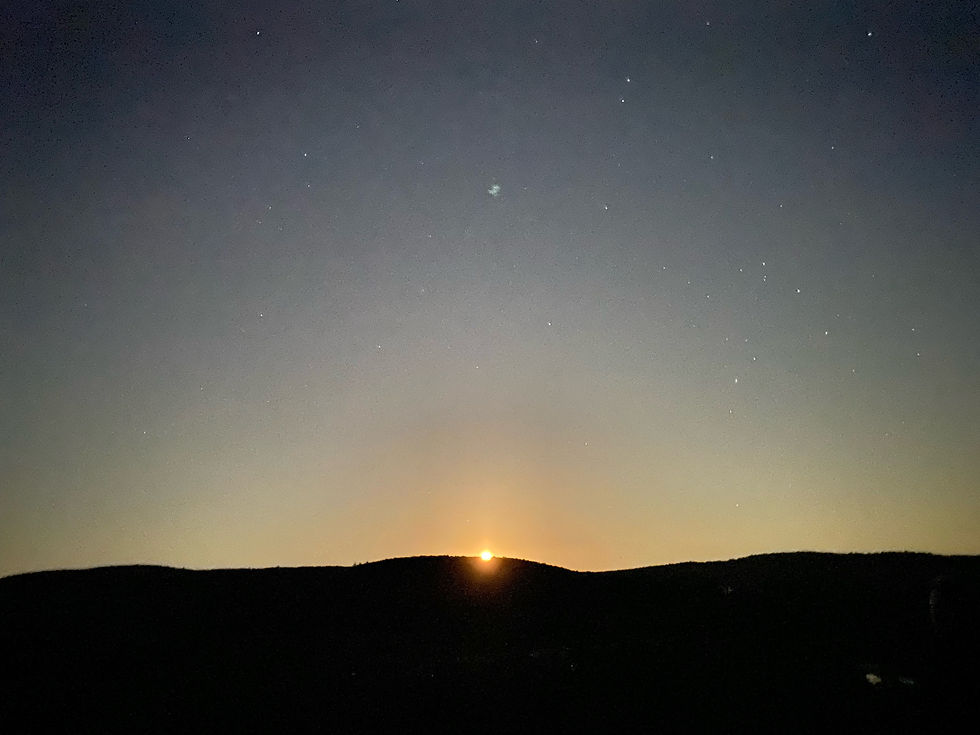May Baskets
- Todd DeGarmo

- Apr 28, 2021
- 8 min read
Come springtime, generations of children in the greater Glens Falls area would spend weeks making May Baskets to distribute to friends and neighbors on the first of May.
I was new to the area in the mid-1980s, and learned of this local tradition through recording local memories, and reading newspaper accounts, noting activity from Warrensburg and Lake George to Glens Falls, Hudson Falls, Fort Edward, and further south along the river to Fort Miller and Schuylerville, going back over 100 years.

Historically, May baskets have been traced to Great Britain, where the return of Spring was celebrated with singing, dancing, and abundance of flowers. Flowers made into wreaths and garlands decorated doorways, maypoles, and the local May Queen. Children presented flowers door-to-door, singing carols and carrying the Lady of May, in return for small gifts or money for the church.

The custom traveled to America, noted in the late 19th century by Lina and Adelia Beard in their 1887 book, The American Girls Handy Book: "A May-day custom, and a very pretty one, still survives among the children in our New England States. It is that of hanging upon the door-knobs of friends and neighbors pretty spring-offerings in the shape of small baskets filled with flowers, wild ones, if they can be obtained; if not, the window-gardens at home are heavily taxed to supply the deficiency."
As early as 1896, The Post-Star (Glens Falls) reported, "The little ones enjoyed hanging May baskets last evening" in Fort Edward, and up the road in Sandy Hill (Hudson Falls), they tell of a group of 15 to 20 children, ages 8 to 12, delivering the baskets. In 1900 it's noted for Glens Falls, "Many of the representatives of the younger generation were out last evening, leaving remembrances in the form of May baskets at the homes of their friends." By 1919, it is called a custom relatively unique to the area: "In spite of the heavy rain last night hundreds of young people throughout the city followed the old time custom of 'hanging May baskets'... While it has been the custom here for many years to hang the baskets, filled with candy and flowers, on the first day of May, in many communities the idea is unheard of."
Locally, I was told, May baskets were originally homemade. Children spent hours finding and putting together just the right materials. Old boxboard containers of all shapes and sizes were used. Folks in Warrensburg remember using small ice cream cups or matchboxes. Many cut-down oatmeal boxes or milk containers. In Schuylerville they salvaged the cones that held thread from a Schuylerville knitting mill for a cornucopia appearance.

The containers were then covered with colorful tissue papers and decorated with twisted crepe paper flowers. A handle was added, using paper, string, a pipe cleaner or salvaged twist of some kind. The American Girls Handy Book (1887) gives similar instructions for making baskets: "The dainty little baskets which are used by the Mayers are generally of home manufacture. They are made of almost any material, and in a variety of shapes. Some, constructed of cardboard, are covered with crimped tissue-paper, or with gilt, silver, or colored paper. They are never large unless flowers are plentiful, and even in that case a small basket is prettier."
The May baskets were then filled with spring flowers, popcorn, and/or candy. Fay Crandall, who grew up in Warrensburg, recalled, "I'd fill them with violets because violets were usually out, and sometimes mother would make up some candy and I'd put that in." A 1919 local newspaper article noted many beautiful baskets, and in particular, a "fine basket" by Miss Lydia Barker of Third street, contained "candies, bananas and eggs."

There was a technique to delivering the baskets, as described in American Girls Handy Book: "When the dusky twilight approaches, it is time for the merry bands of young folks to start out on this lovely errand of going from house to house, leaving behind them the evidence of their flying visit in these sweetest of May-offerings. Silently approaching a door, they hang a May-basket upon the knob and, with a loud rap, or ring of the bell, scamper off, and flee as though for life."
Ruth Jenkins, who grew up in Fort Edward, confirms the technique, "We used to fill them with candy and sneak up to friends' houses, hang the baskets on the doorknob and run." Marie Herrick of Schuylerville remembers, "You'd go around and hang 'em on the door. Knock on the door and run. You might put your name inside, but you'd run. You didn't want them to catch you at it."
In 1932, The Post Star calls attention to a variation in the custom, giving advice to the young people: "If your doorbell rings tomorrow, lose no time in answering it, because it probably means that an admirer has left a May basket hanging on the knob. It has been said by good authority, that the donor, after ringing the bell, will make a hasty retreat, but not to any great distance, because the recipient is supposed to catch him or her, as the case may be, and deliver a reward for the gift, which, so the custom goes, is a kiss."

Indeed, some of the May baskets were more special than others. Marie Herrick of Schuylerville told me in 1989 of one in particular from an admirer that she still remembered: “I remember one I received. And that was a long time ago. It was from Kilmer Myers. He lived over here in the white house on the hill. It was an ice cream container. And inside of it there was a cup. And in the cup there was all these pretty little flowers and a vine that came up out of it, and candy all around it. I can remember that.”
In 1947, the newspaper reports a memorable delivery of a May basket to Mildred Saunders. She was sick with the whooping cough, staying with her grandparents in Fort Miller. Her uncle, Major Curtis Betts, flew a large plane from Champaign Illinois, circling the hamlet several times before dropping a May basket safely in the front yard.

May baskets also became a lively business in the region, with the handmade creations being sold by organizations as fundraisers. They were also found in a variety of the stores, and sold by private individuals. As early as the 1880s and well into the 1950s, newspapers advertised May baskets made and sold by churches (Presbyterian, Episcopal, Baptist, Friends, Methodist) and volunteer/service organizations (Sons of Veterans, Order of the Eastern Star, Girl Scouts, Glens Falls Hospital Guild).
Stores are also involved, selling the raw materials needed to make them (including the colorful tissue and crepe papers) from places like Empire Stationery at 24 South in 1918, or Russell and Wait at 122 Glen in 1925, or Vaughn Sporting Goods in 1964. Businesses also sold peanuts, popcorn, hard candies, and jelly beans specifically to fill the May baskets from places like Scott's Sons at 18 Ridge in 1915, or Dolan's Quality Candy Shop at 43 South in 1923. Sometimes stores allowed organizations to sell May baskets on site, or they'd have their own line of May baskets to sell. The Baptists used Robinson Hardward on Ridge Street in 1916. Scott's Sons sold ready-made baskets for 5 cents each in 1915; Fowler's for 19 and 29 cents each in 1952; CVR Discount House at 114 South, 2 for 45 cents.
Over the years, the newspapers also noted May Baskets for sale by individuals:
Miss Helen Scott at 108 Ridge Street in 1911 and Mrs. L. G. Boynton at 3 Thompson Avenue in 1930. A 1947 headline states, "Woman Has Made 1000 May Baskets" telling the story of Mrs. Frank Aubrey at 11 Griffin Ave. who "has been the center of this May basket industry for this village. ..supplying stores in Glens Falls, Hudson Falls and Fort Edward... [turning] out May baskets of original and unusual designs and shapes, no two alike." In 1955 it's reported that 82 year old Mrs. George Grover made 800 May baskets, with 40 of them going to Texas to begin the custom there. And well into the 21st century, numerous articles name Nickie Piscitelli of Hudson Falls the queen of May baskets, for making thousands every year, and selling them from her grocery store, and at places like Boston Candy Kitchen.

By 1950, a "May Basket problem" seems to arise in the region. An advertisement from Ridge Book Shop, 228 Glen Street: "May Baskets must be hung the evening of May Day which is Thursday of this week and for May Baskets just the right size, design and price, we suggest Hallmark Baskets which can be made in a jiffy. They are the answer to the May Basket problem and are priced at 50c for a package of five."
An editorial in The Post-Star on May 1, 1950 lays out the issue as they saw it, stating "May Day has lost some of its charm and most of its blushing thrills."
"Time was, and the middle and older generations recall it with regret, when May Day was a sentimental occasion and didn't cost anything. One gathered a bunch of wild flowers... the posies were fixed up up with some ribbons or maybe a doily, and this creation was surreptitiously hung on the best beloved's doorknob. The offering bore no identifying markings and one did not linger after hanging it but one could hope that the party of the second part was peering from behind the shelter of the parlor curtains."
But nowadays, "...the May basket is getting to be quite as much of a problem as the Christmas card... hanging the May basket is quite a process. First there must be a list of all from whom baskets were received last year plus a score of new friends and school acquaintances. Then, if mother does not go downtown and buy the works ready-made she must get an idea after which she purchases the materials necessary for its execution. Comes then the manufacturing process and for a week, wherever the family walks or sits, it crushes May baskets... The wild flower has yielded to crepe paper, peanuts, jelly beans, popcorn, lollipops and such like, and in some neighborhoods the contents must be identical because there will be comparisons made."
Though I've been told of some small scale family or neighborhood May Basket activity during the 1950s onward, the tradition seems to disappear as a large scale children's activity in the region.

But then about 1984, the Seniors of the Moreau Community Center began making May Baskets in a big way, to raise enough money to buy a new refrigerator. Members like Effie Lyons, Ruth Jenkins, Blanch Hopkins were behind the effort. These folks first practiced the custom of making and delivering May baskets as kids, and then taught their own children. Now over 30 years later, this effort has grown, with the group making thousands of baskets and umbrellas to sell. In 2017, Stewart's Shops donated 1200 milk cartons towards their efforts. One year they ran out of milk cartons and used Pepsi soda cups to make up the difference. They raise thousands of dollars every year, the money then donated to various community organizations and events.
In the 1990s I asked the Moreau Seniors to share the May basket tradition, and for a number of years, these seniors agreed to teach a new generation of children, as a part of our workshop series, Growing Up in the North Country. We also purchased an assortment of their May Baskets and Umbrellas for our Folk Art Collection. These May Baskets are currently on display through October 23, 2021 at the TAUNY Center in Canton, New York in the exhibition, Folk Arts All Around Us, guest curated by Todd DeGarmo, showcasing our Folk Arts Collection.
For more information:
May Baskets and Umbrellas by the Moreau Seniors, Folk Art Collection, The Folklife Center at Crandall Public Library, Glens Falls, NY.
"May Baskets" in Todd DeGarmo Folklife Research Files, The Folklife Center at Crandall Public Library, Glens Falls, New York.
May Basket workshop slides by Todd DeGarmo, Growing Up in the North Country, Spring 1991.
Life in a Mill Town by Todd DeGarmo. Ballston Spa, NY: Brookside, 1990.
The American Girls Handy Book: How to Amuse Yourself and Others, by Lina and Adelia Beard, 1887.












Comments